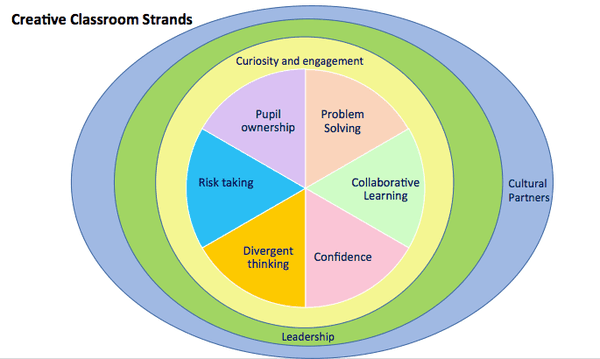Benton Dene School resources
Creative Classrooms
Creative classrooms are deliberately and consciously planned learning spaces which give an opportunity for students to learn with fun, to express themselves freely and to follow their passions. There is a focus on practical activities which make room for productive discussion, problem solving and visual reflection. Together these ingredients stimulate imaginative, critical and innovative thinking capabilities, as well as, providing emotional security and an opportunity to grow in confidence as both a person and as a learner.
Our resources have two main purposes:
Within each topic we'll be looking at:

The Quality Principles Toolkit is designed to support both schools and cultural organisations in using the Quality Principles.
Within the Toolkit, there are several resources, editable and printable versions of which can be downloaded here.
1) The Quality Principles confidence wheel (page 7 of the Toolkit)
Consider your practice as a whole, in relation to working with children and young people. Rate how well you feel your current work embodies each of the Quality Principles (the closer to the bullseye, the more confident you feel). Why do you think this is? What are your next steps for each one?
2) The Quality Principles reflection grid (pages 8 and 9 of the Toolkit)
List key elements of your programme down the left hand side of the grid (eg specific projects, ongoing elements of your offer, long-running clubs or groups for young people), then complete the grid to show how each element links to each of the Quality Principles. Not every box will be filled for every every project; this is more about looking at your programme as a whole.
3) Next steps with the Quality Principles (pages 12 and 13 of the Toolkit)
The Quality Principles aren't just a tick list of things to achieve - each one is a progression and it's always possible to develop practice around each principle. Use this tool to build a pathway and think about what the Quality Principles could look like in your work.
Choose the principle(s) you want to focus on, and think about what an emerging level of practice around this would look like - where are the starting points? Then move to the next box - how would you know you were secure in your work around this principle, and were making solid links to it? Finally, what would best practice look like here? What could your aspirations be? Your completed table will help you see what your next steps are and what success will look like.
4) Quality Principles planning template (pages 20 and 21 of the Toolkit)
Plan projects, units of work, or individual workshops or lessons against the Quality Principles, thinking carefully about how the work can embody each one. Use the prompts for each principle to ensure you've covered all angles. If you're working in partnership with an arts organisation or school, having everyone contribute to this plan gives clear shared goals. This structure of planning also makes it easy to reflect afterwards on successes and potential improvements.
5) The Quality Principles: interpreted by Year 3, St Joseph's RCVA Primary School (page 22 of the Toolkit)
St Joseph's Year 3 pupils were tasked with creating their own child-friendly version of the Quality Principles as part of a guided reading lesson; children worked in groups to analyse each principle and get to the heart of its real meaning.
6) An evaluation framework using the Quality Principles (page 25 of the Toolkit)
Using the statements as starting points for evaluation discussions as a simple way to measure the impact your work is having against the Quality Principles. How much do participating young people agree or disagree with each statement? Do their viewpoints change during the project?
7) Pupil target wheel (page 27 of the Toolkit) and 8) Teacher/cultural practitioner target wheel (page 28 of the Toolkit)
Use these to measure progression during a project, by asking all project partners and participants to complete them at the beginning, and then again at the end of the work. Wheels for pupils and staff ensure everyone's voice is heard. Use the wheels completed at the beginning of the project to help shape its direction; do you want this work to fill gaps? Or play to strengths?
9) Family activity feedback form (page 29 of the Toolkit)
This form is an example of how the Quality Principles can be used in the evaluation of less formal drop-in activities as well as longer, more structured projects. Use the statements to collect information from your audiences.
10) Sharing your Arts Award experience sheet (page 31 of the Toolkit)
Align the Quality Principles more closely with your Arts Award work by including this sheet in your Discover and Explore portfolios. Use it to encourage the children and young people you're working with to reflect upon their experiences and consider their own personal development.
Benton Dene Special School regularly use AccessArt’s visual arts resources to help inspire their own teaching practice. Check out all of their resources here >>
If you're a SEND teacher and you would like some additional support in showing the progress of your pupils or you'd like to find out more about the SEND podcast check out the links below.
This handbook supports EYFS practitioners in making accurate judgements about each child's attainment in 2020.